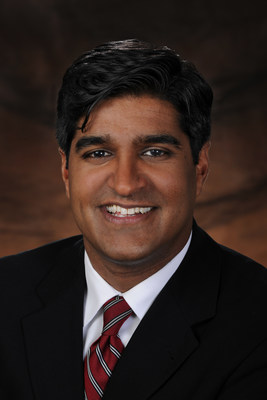HOPEWELL, N.J., Jan. 29, 2021 /PRNewswire/ -- Kim Schappell had been living for weeks with a pain in her thigh she couldn't explain. There was no recent injury or change in her routine that she could remember, so why did it hurt so much? Over the next few weeks the pain got worse, and even a couple of trips to the emergency room couldn't identify the problem. "It just hurt so badly, but no one could figure out what was wrong," said Kim.

The pain continued until she could barely walk, until one day, disaster struck. "I was just standing there and my leg broke," Kim recalled. "I couldn't believe what was happening." A series of medical visits and a referral to an orthopaedic specialist finally identified the problem: Kim had cancer of her femur, and her leg had broken through the diseased bone.
Although cancer spreading to the bone from other sites is common, cancers that start in the bone are not. Kim's cancer was osteosarcoma, a form of the disease that starts in the bone when cells lose their regulatory processes and start dividing uncontrollably. There are only about 1,000 new cases of osteosarcoma in the United States per year, but it is an aggressive cancer that tends to spread quickly, primarily to the lungs. Treatment, which lasts for about a year, usually involves a combination of aggressive chemotherapy and surgery.
Kim and her family were shocked by the diagnosis, but the worst news was yet to come. Kim was told she needed an immediate amputation at the hip and would not be able to walk again. "The doctors who saw me initially were convinced that the tumor had spread throughout the leg from the fracture and that there was no choice but amputation," said Kim. "They felt that this should be done immediately to control the tumor before it spreads."
Kim, however, was not going to give up her ability to walk so easily. "It was at that point that I realized I needed a specialist who knew how to treat this cancer. I wanted to walk, and I wanted to keep my leg."
After a thorough search of doctors in the region, Kim decided to trust her leg and her life to Dr. John Abraham. Dr. Abraham has 15 years of experience in dealing with bone and soft tissue cancers of the extremities like Kim's and is the founder of the Orthopaedic Oncology Service at Rothman Orthopaedic Institute, a program he has led for nearly 10 years. As part of Capital Health's ongoing partnership with Rothman Orthopaedics, Dr. Abraham offers orthopaedic oncology services at Capital Health Medical Center – Hopewell.
"As soon as I met Dr. Abraham and his team, I knew I was in the right hands," said Kim. "He was very clearly comfortable with treating my cancer, and he knew how to explain the disease to me in a way that made sense. While he never promised it would be easy, he told me there were treatment options that didn't involve losing my leg."
"Capital Health is one of the fastest growing health systems in New Jersey, and the robust growth is driven in larger part by its Cancer Center," said Dr. Abraham. "The multidisciplinary team of specialists there is dedicated to providing the highest quality of care to their patients, and the Center offers some of the most advanced treatment options I've seen. We built the Rothman Orthopaedics Oncology program from the ground up over the last decade, and Capital Health was the obvious choice for the expansion of our program into New Jersey."
After her initial consultation with Dr. Abraham, Kim's leg was casted and she began chemotherapy. "As concerned as we were about her leg, the real killer is the disease that sheds from the leg and into the blood stream, trying to get into the lungs," said Dr. Abraham. "Once we stop that, we can deal with the leg itself. It is difficult treatment, but it works."
Kim indeed struggled with the side effects of chemotherapy, but kept her eye on the prize. In spite of the difficulties, Kim always had a lifeline in the form of registered nurse Leah Newell, Dr. Abraham's nurse and the main point of contact in his office.
"Leah was my angel," said Kim. "I could call her any time about any problem and she would always know what to say or do to help me. This is the kind of communication people should be able to expect when they are getting treated for cancer, because of how scary it all is. I'm not sure I could have gotten through all this without her."
Following Kim's initial round of chemotherapy, she was finally ready for surgery. To begin, Dr. Abraham ordered a battery of tests to clearly identify the anatomy of the cancer. This included a CT scan, an MRI, and even a specialized blood vessel test called a CT-Angiogram which shows exactly where the critical blood vessels are in the region of a tumor. This allows Dr. Abraham and his team to carefully remove the blood vessels from the tumor during surgery. For this, He enlisted Dr. Christine Lotto, a board certified and fellowship trained vascular surgeon at Capital Health. "I've worked with Dr. Lotto for many years and knew she would be a great help in Kim's case."
The procedure lasted more than five hours and involved removing half of Kim's femur, the largest bone in the human body. Dr. Abraham eliminated the tumor involving the bone and the surrounding soft tissues, as well as all the tissues that were contaminated by the fracture. Once the tumor was removed, a metal femur was mated to Kim's remaining bone and a complex hinged knee replacement connected the metal femur to the rest of her leg.
"I remember waking up from surgery and hearing from Dr. Abraham that the tumor was gone," said Kim. "When I looked down and saw my leg, I had never been so happy to be able to wiggle my toes!" Within a few days Kim was on her feet again and beginning the rehabilitation process. The pathology report a few weeks later confirmed that the tumor had been completely removed in spite of the fracture and the cancer was mostly dead from the chemotherapy, an excellent indicator for Kim's overall outcome.
Kim's story is not yet complete. She requires several additional months of chemotherapy and significant physical therapy to complete her treatment. After that, the standard follow-up routine involves getting scans every three months for two years, followed by scans every six months up to year five to make sure the cancer is not returning. "We are going to become friends," Dr. Abraham said after explaining the surveillance process to Kim, to which she replied, "We already are!"
Kim couldn't have been happier with her choice to have her bone cancer treated with Rothman Orthopaedics at Capital Health. "They saved my leg, they saved my life, and they treated me with dignity and respect the entire time. I'm so glad I found Dr. Abraham and his team at Capital Health and Rothman Orthopaedics."

![]() View original content to download multimedia:http://www.prnewswire.com/news-releases/rothman-bone-cancer-specialist-saves-lives-and-limbs-at-capital-health-301218267.html
View original content to download multimedia:http://www.prnewswire.com/news-releases/rothman-bone-cancer-specialist-saves-lives-and-limbs-at-capital-health-301218267.html
SOURCE Capital Health Cancer Center





















